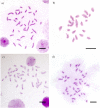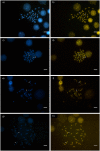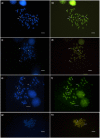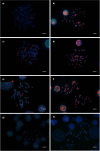Cytogenetic studies on populations of Camponotus rufipes (Fabricius, 1775) and Camponotus renggeri Emery, 1894 (Formicidae: Formicinae)
- PMID: 28520797
- PMCID: PMC5433764
- DOI: 10.1371/journal.pone.0177702
Cytogenetic studies on populations of Camponotus rufipes (Fabricius, 1775) and Camponotus renggeri Emery, 1894 (Formicidae: Formicinae)
Abstract
Two valid ant species, Camponotus rufipes and Camponotus renggeri, have recently been the subject of a broad discussion with reference to taxa synonymization. Both species are quite common among the Neotropical myrmecofauna and share some unique traits, such as the shape of the scape and the pilosity patterns of the tibiae and scapes. A single morphological trait can help distinguish these species; however, only a combination of different approaches can enlighten our view of the complex phylogenetic relationships prevailing in the different populations of these two taxa. Therefore, focusing on the taxonomic issues concerning these two species, a cytogenetic survey including 10 populations of C. rufipes and two populations of C. renggeri was performed. In order to better understand the extent of the relationship between C. rufipes and C. renggeri, two common Neotropical Camponotus species, C. atriceps and C. cingulatus were taken as outgroups. All four species of Camponotus that were studied had 2n = 40 chromosomes (4sm+34st+2t); however, the abundance of chromosome rearrangements observed, combined with several chromosome markers, suggest that C. rufipes and C. renggeri are two good distinct species although closely related. The already reported chromosome translocation 2n = 39 (1m+4sm+32st+2t) for C. rufipes has been found in different populations as in the unprecedented chromosome inversions found both in C. rufipes and in C. renggeri populations. Within the C. renggeri chromosome inversions, both the heterozygous state 2n = 40 (1m+3sm+34st+2t) and the homozygous state, 2n = 40 (2m+2sm+34st+2t) were identified. However, only heterozygous specimens for chromosome inversions were found among C. rufipes, with karyotype configurations distinct from those found in C. renggeri, with 2n = 40 (1m+4sm+34st+2t). None of the populations studied showed signs of mosaic individuals. With respect to rDNA clusters, the 18S rDNA seemed to be more restricted inside the genome, as C. renggeri showed four 18S rDNA clusters, whereas, C. rufipes, C. atriceps, and C. cingulatus showed only two clusters. The chromosome locations of the 5S rDNA clusters were pointed for the first time in Formicidae, and showed itself to be more widely spread over the genome. By combining different chromosome banding approaches it was possible to demonstrate the crucial importance that chromosome inversions played on the karyotype evolution within these ants. The results also showed that chromosome translocations might be a consequence of the chromatin dynamic condition observed among Camponotus species. The homozygosis condition found in a C. renggeri from a Brazilian savanna population for chromosome inversions and the contrasting heterozygous condition for a different kind of chromosome inversion in C. rufipes from the Brazilian coastal rainforest, opens the window for a chromosome race hypothesis within the group C. renggeri and C. rufipes. The wide distribution, rich ecological interactions, genetic diversity, and morphological variability among C. renggeri and C. rufipes justify questioning of the actual taxonomic status of these species. The answer of this puzzle is clear when observing the number of 18S rDNA clusters of these ants, as C. rufipes has only two clusters whereas C. renggeri has four.
Conflict of interest statement
Figures








References
-
- Mayr E. Populations, species, and evolution: an abridgment of animal species and evolution. Harvard University Press; 1970.
-
- Mayr E. What Evolution Is? Clays ltd, St Ives pic Press, Great Britain; 2001.
-
- Wilson EO, Brown WL The subspecies concept and its taxonomic application. Syst Zool. 1953; 2(3): 97–111.
-
- King M. Species Evolution: The role of Chromosome Change. Cambridge University Press; Cambridge; 1993.
MeSH terms
Substances
LinkOut - more resources
Full Text Sources
Other Literature Sources

